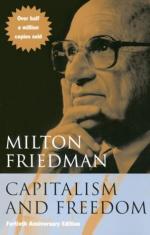
|
| Name: _________________________ | Period: ___________________ |
This test consists of 15 multiple choice questions and 5 short answer questions.
Multiple Choice Questions
1. In Chapter 3, what does Friedman provide a history of?
(a) British colonialism.
(b) The Federal Reserve System.
(c) American monetary policy.
(d) World War I.
2. Friedman uses the example of selling ______ to demonstrate a true global economy.
(a) Oil.
(b) Wheat.
(c) Corn.
(d) Rice.
3. The original balancing thought is based on whose economic philosophy?
(a) Marx.
(b) Smith.
(c) Krugman.
(d) Keynes.
4. Friedman believes that government that has the power to do good, also has the power to do ______.
(a) Bad.
(b) Nothing.
(c) Wrong.
(d) Right.
5. In Friedman's mind, why is centralization attractive to many?
(a) Streamlined services.
(b) Consolidation of power.
(c) Government can promote the public interest.
(d) Better pool of resources.
6. According to Friedman, it can be argued that private schools ______ class distinctions, and therefore need government intervention.
(a) Maintain.
(b) Increase.
(c) Diminish.
(d) Exacerbate.
7. Friedman makes the distinction between education and ______.
(a) Schooling.
(b) Instruction.
(c) Aging.
(d) Income.
8. Friedman advocates that individuals should be able to buy and sell ______.
(a) Foreign currency.
(b) Stocks.
(c) Silver.
(d) Gold.
9. Which of the following does Friedman dispute?
(a) Government should stay out of individual economic choices.
(b) The Central Bank holds too much power.
(c) A free market economic system works.
(d) The gold standard for backing money is good.
10. Friedman's evidence suggests that for every $100 of government spending, a certain amount is added to income. How much?
(a) $100.
(b) $300.
(c) $150.
(d) $50.
11. In Friedman's opinion, what should individuals be allowed to do?
(a) Print their own money.
(b) Pursue their own ends.
(c) Elect their own leaders.
(d) Choose their own religion.
12. According to Friedman, what is liberty's greatest enemy?
(a) The Federal government.
(b) Concentration of power.
(c) The educational system.
(d) Elected leaders.
13. Friedman states that the problem with teacher salaries is not that they are too low, but that they are ______.
(a) Not inclusive of benefits.
(b) The same regardless of quality.
(c) Linked to the amount of education the teacher has.
(d) Computed based on seniority.
14. What is the name of the system with the purpose of regulating monetary policy between leading countries?
(a) The Gold Standard System.
(b) The World Bank System.
(c) The International Monetary System.
(d) The Bretton Woods System.
15. How are decisions, for Friedman, made where unanimity is a costly way of making decisions?
(a) Majority rule.
(b) Decisions by committee.
(c) A system of checks and balances.
(d) Executive decision.
Short Answer Questions
1. Friedman asserts that government restriction centralizes ______.
2. In Friedman's time, what was illegal to buy or sell?
3. One solution Friedman proposes is to give parents ______ for schooling.
4. Friedman argues against the theory that $100 in government spending will increase income by ______.
5. What does Friedman believe will markets do over time to monopolies?
|
This section contains 418 words (approx. 2 pages at 300 words per page) |

|




